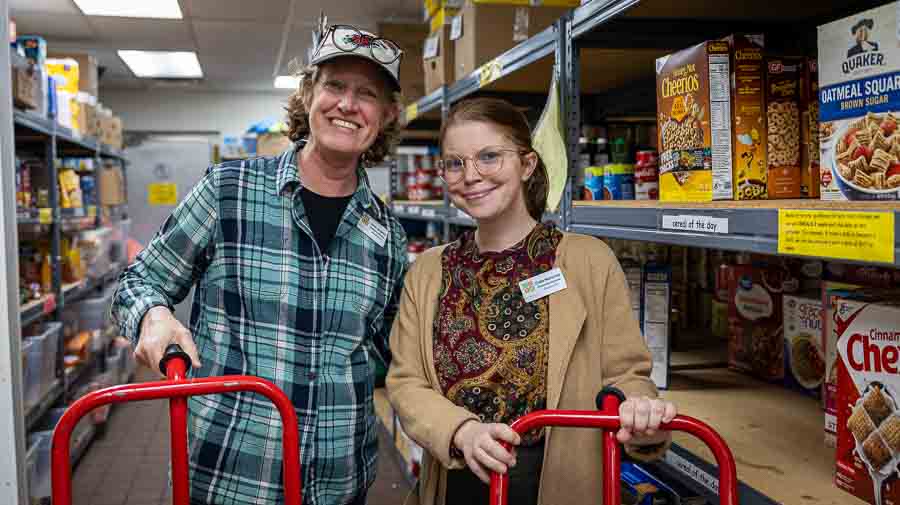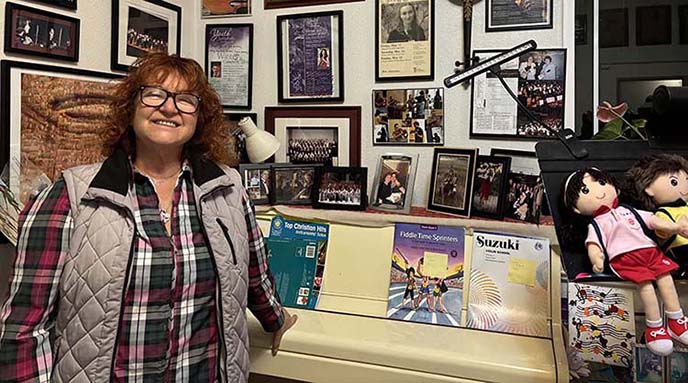Rogue Valley Manor’s parent company presents senior living facility proposal to community, faculty; Second company offered its proposal Friday afternoon
By Holly Dillemuth, Ashland.news
An estimated 120 to 150 attendees, many members of Osher Lifelong Learning Institute (OLLI), trickled into Southern Oregon University’s Recital Hall on Wednesday morning to learn more about the Rogue Valley Manor’s parent company Pacific Retirement Services and its pitch to operate a senior living housing development proposed for the Ashland campus.
The Medford-based nonprofit is one of two finalists presenting this week to both the community at large in Ashland as well as faculty and staff at SOU about how to make the concept of multi-unit housing facility on the site of the now-demolished Cascade Hall Complex a reality.
SOU’s Recital Hall also hosted the final presentation by St. Louis-based for-profit company McCormack Baron Salazar on Friday. (Link to separate story on that presentation will be added when available.)
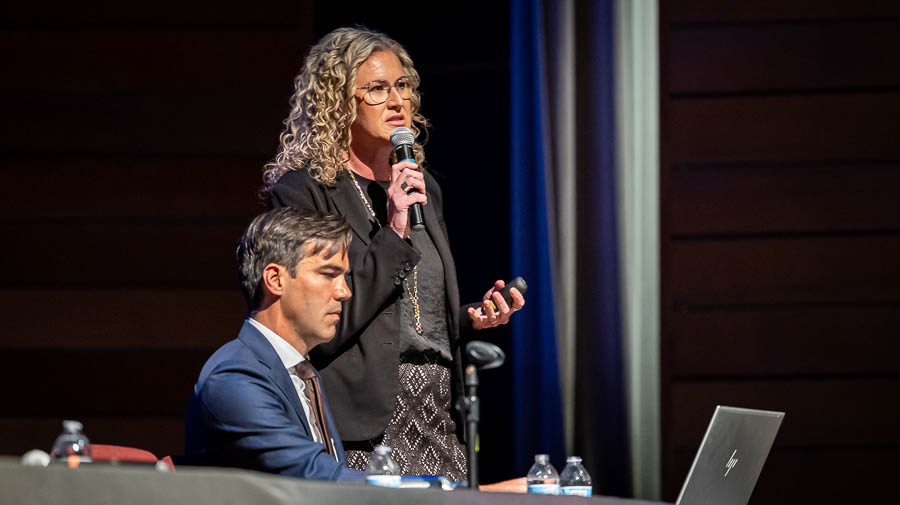
More than 50 questions about the proposed project were submitted online to SOU leading up to the PRS presentation Wednesday, according to SOU General Counsel Rob Patridge, ranging from whether pets would be allowed on site to general aesthetics about the project, some of which are not yet known until a partnering developer is selected.
Patridge emphasized that the university is in the midst of trying to choose a partner that will help “plan, develop, and operate” the community.
“Right now, we’re looking at ‘what’s the right fit for SOU?’” Patridge said. “‘What’s the right fit for Ashland?’ Then, together, we’re going to develop the financial model and the programming.”
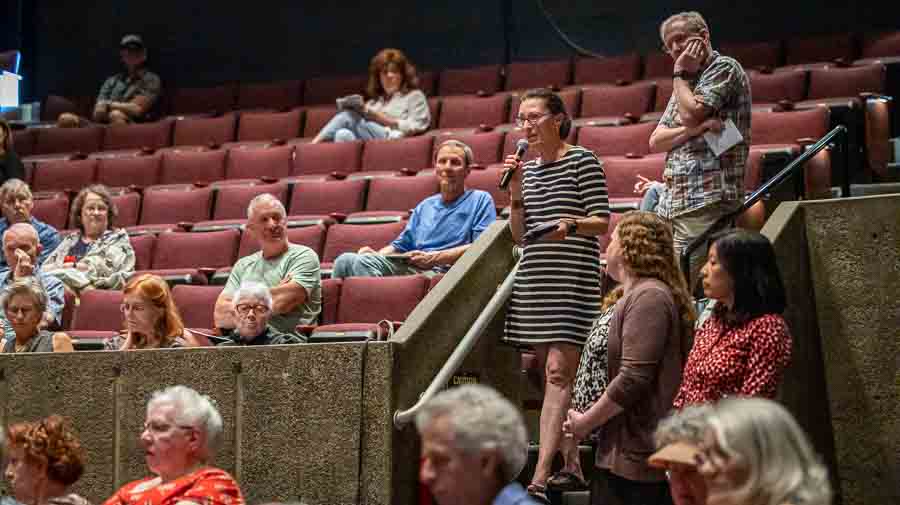
Pacific Retirement Services
Sarah Lynch, vice president of Strategic Development for PRS, and Eric Mineart, vice president of Strategic Innovation at PRS, and members of the PRS leadership team outlined the company’s overall mission and pitched the company’s proposal to SOU. Leaders touted PRS’ already established partnerships with SOU, such as its OHSU Nursing program with students who perform clinical hours at the Manor as well as having local roots in the communities the Manor serves.
Lynch has served PRS for more than 20 years, including as former executive director. She shared about her deep roots in the Rogue Valley, noting that her parents returned to Southern Oregon when she was in third grade.
Graduating from Linfield College in McMinnville, Lynch said she’d initially planned to teach and coach high school seniors.
“I did my student teaching and it turns out, I am so much better with retired seniors than I am with high school seniors,” Lynch said. “So I’d like to think I skipped work altogether and went straight from college into retirement and never looked back.”
Posing the question of how many have heard of the Rogue Valley Manor, hands flew up throughout the audience, including from those who currently live at the Medford campus, and those on the wait list.
“A lot of people say we’re in the business of healthcare and I say we’re in the business of people and community,” Lynch told attendees. “When you’re in the business of people and community, you work together, you involve all stakeholders, you collaborate and you do all of the things that we know are important to make and build a great community.”
Lynch noted she was part of an effort a few years ago to recreate the company’s mission and vision statement to better reflect the purpose of the organization.
“What came of that is a new mission statement to empower people to live more meaningful lives as they age,” Lynch said.
“We want to shape a future where aging is embraced as an opportunity to thrive,” she added.
The Manor opened in 1961 with about 300 apartments in addition to one high-rise building.
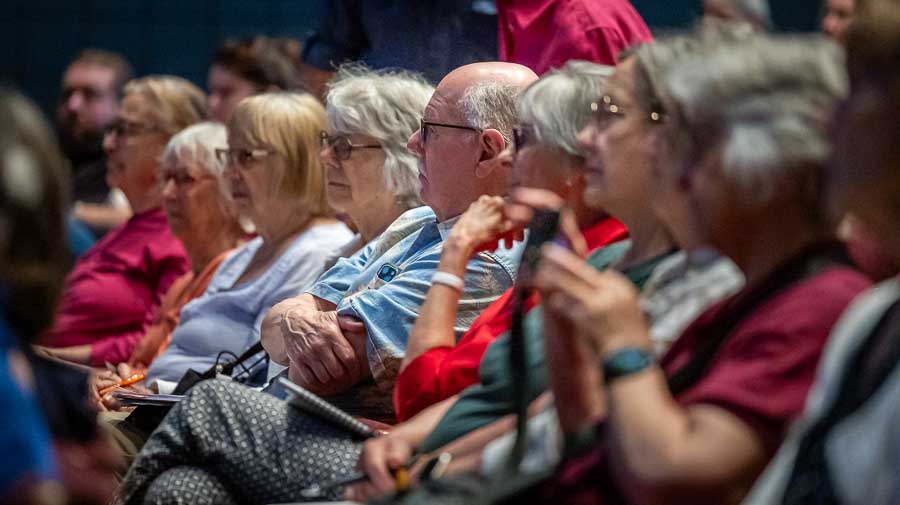
“Since that time, we have grown tremendously,” Lynch said, of the sprawling, 668-acre Medford campus. “We now serve over 900 residents. We have between 500 and 600 employees on any given day, depending on what’s happening with staffing, and we know all of the challenges that we face there on a regular basis.”
PRS, in addition to the Rogue Valley Manor, has locations across Oregon and the nation, including Mirabella in Tempe, Arizona, an innovative university-based community, according to the summary submitted by PRS.
Mineart, with PRS for 18 years, also emphasized his love for working with seniors at the Rogue Valley Manor and a desire to expand Manor services to Ashland.
“You accomplish great things as a community and that’s what we’re excited about, the opportunity to build something local that makes the community of Ashland stronger, better, more resilient, and we think we can do that with our proposal,” he said.
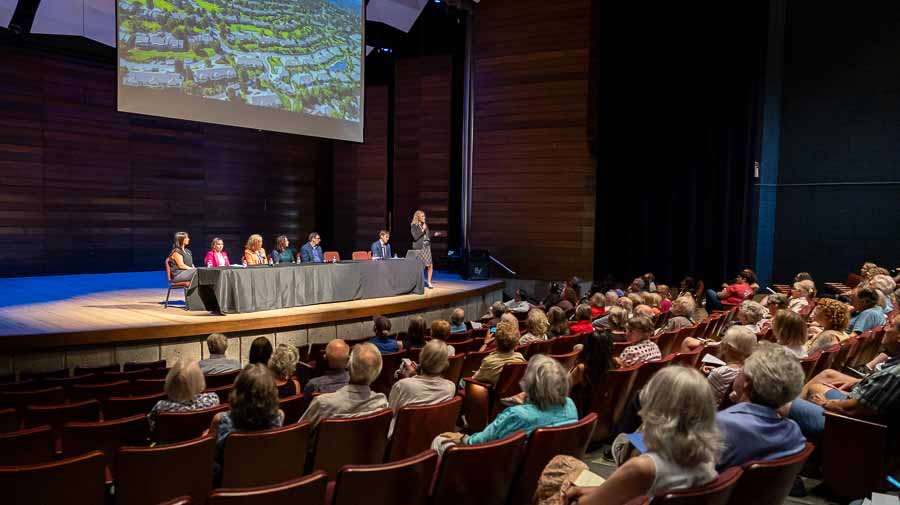
PRS envisions nearly 200 apartments
A summary proposal by PRS submitted to SOU lays out a vision for a community “that fosters intergenerational learning, community engagement, and healthy aging while supporting SOU’s educational mission and financial sustainability.”
The concept estimates 165 to 185 independent living units, in addition to public spaces, such as a dining hall and wellness center. The proposed development would tentatively be completed by late 2028 or 2029, depending on construction timelines and public interest
(The number of units and timeline for the project is dependent on many factors, and is potentially not the same for both candidates, according to SOU).
“We recommend a Life Plan Community model where residents pay an initial entrance fee in exchange for lifetime residency and care,” stated the summary proposal. “Residents of the SOU-based community will also pay ongoing monthly fees to cover the cost of community operations, including dining, housekeeping, wellness classes, and other services.”
Options proposed by the Rogue Valley Manor include building a satellite campus on site in Ashland, a model that the company states “leverages Rogue Valley Manor’s established brand, healthcare infrastructure, and regional reputation for excellence, according to the proposal.”
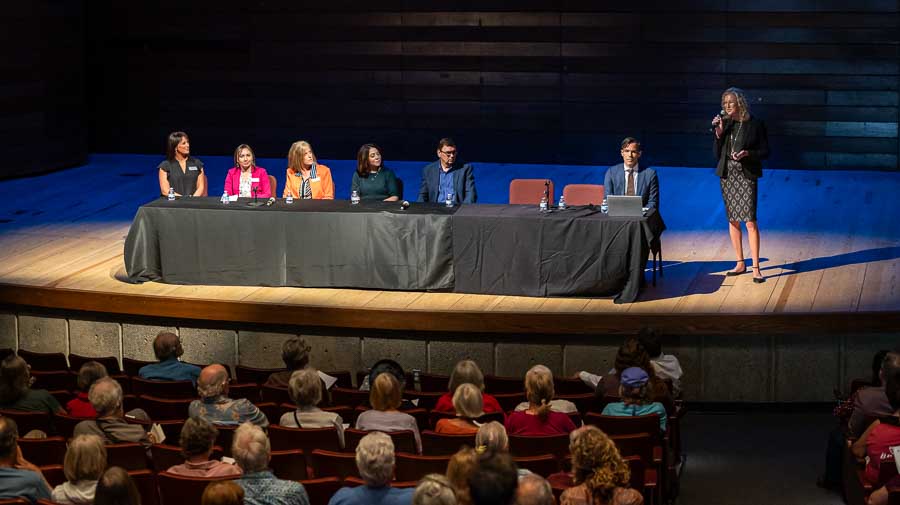
This option would provide SOU with immediate access to a large lead base, proven operational infrastructure, reduced development risk, and shared operational costs, according to PRS.
“And for (Rogue Valley Manor), such a partnership offers more opportunities for residents who already enjoy Ashland’s theaters, restaurants, art scene, and Osher Lifelong Learning Institute programs,” reads the statement.
The second option would be a “new standalone community brand.”
“This model reflects Ashland’s artistic spirit, academic vitality, and connection to nature to inspire new possibilities for living well,” the summary states. “The community’s design incorporates elements that reflect Ashland’s biodiversity, energy-efficient systems, and spaces that blur the line between indoors and outdoors.”
If selected for the development, PRS would work with city of Ashland officials to understand how the project can advance municipal goals, according to the proposal, in addition to working with SOU.
As modeled by PRS’s Mirabella at ASU community, residents would be deeply embedded in academic and campus life and could:
- Participate in research, classroom activities, and campus events.
- Support arts and cultural programs with their knowledge, skills and resources.
- Volunteer in university and community initiatives.
- Mentor and advise students.
“It would really provide an opportunity to build on the success we already have in the valley,” he said.
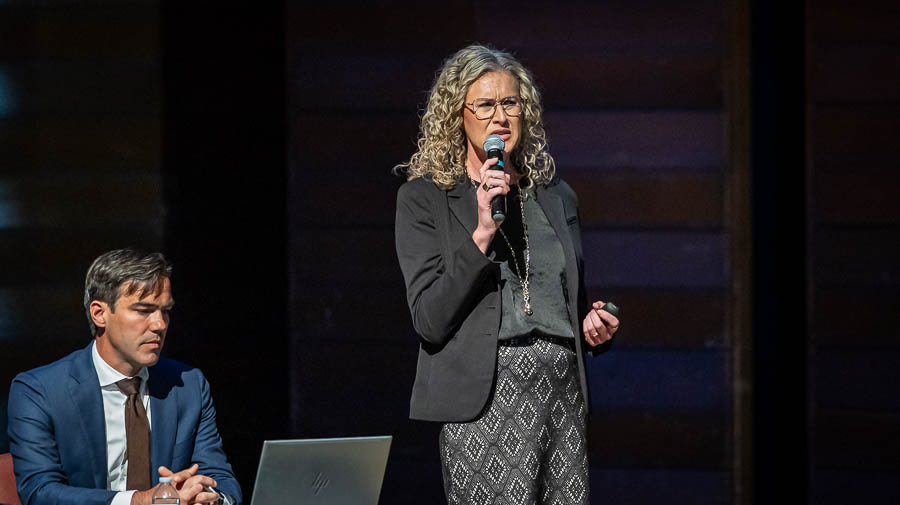
“We do not envision skilled nursing, memory care, and assisted living being built in this community,” he added. “This could be subject to change, based on a community need.”
When asked if those living at the Ashland housing facility could access higher levels of care in the event needed, such as the skilled nursing facility at the Rogue Valley Manor in Medford, Mineart confirmed they could.
“The future of health care, like the future of so much in this country, is very much in question,” Mineart said.
“We envision the community as a whole being able to support aging in place so that if you are discharged home, there is a robust program to actually support you,” he added.
“There are more and more innovative programs that are allowing people to age in place … we see more opportunities coming there so we think this community will be really well positioned even without … licensed care. It fundamentally will still have a health care program.”
Mineart said a primary goal for the development would also be to build with sustainable materials that would support the university’s goal of operating on 100% solar power.
He also emphasized the housing facility would promote an intergenerational community.
“We do not view this as something that would exist apart from SOU and apart from Ashland – It would be deeply integrated and that integration is what allows people to live in the community, to age more successfully,” he said. “It allows them to … contribute to the community in the way that they want to.”
Mineart stressed that PRS is only pitching a proposal at this time and numerous details would need to be finalized for it to come to fruition, including selection by SOU’s evaluation committee.
“The ball is entirely in their court,” Mineart said of SOU.
“We hope you heard loud and clear that what we proposed for this specific location is something that would be distinctly and distinctly part of the fabric of Ashland.”
Patridge moderated a question-and-answer session following the PRS presentation.
Among questions posed during the Q-and-A portion, an Ashland resident asked about the cost to become a resident of such a housing community.
“Because we’re so early in development of this, it’s hard to answer that in a concrete way, but I could speak more philosophically to it,” Lynch said. “I think one of the things that distinguishes Rogue Valley Manor from so many other Life Plan communities is the affordable nature of what we offer.
“The high level answer to that question would be that we want it to be as affordable as it possibly can be while still delivering the superior level of service that we want to, day in and day out, to the people that they serve,” she added.

Former SOU President Elisabeth Zinser was among several in the crowd during the proposal presentation and also spoke with Ashland.news following the forum.
Zinser served as president of SOU from 2001 to 2006. The octogenarian remains active and runs a hiking group in Ashland. She’s on the list to join the senior living community down the road and is excited about the concept becoming reality.
“I’m just extremely excited to be living to the point in my life where I might actually benefit,” Zinser said.
During her time as president, she was part of a master planning effort that included topics such as converting the site of Cascade Hall into senior living as a possibility for the future. She credits Bailey with bringing the idea to life.
“It was a concept, it was an idea about how that space could be used because the demographics here would suggest that’s a possibility,” Zinser said. “I don’t want to suggest that this wasn’t their idea today because they didn’t have to go there.”
Bailey said of all the concepts and projects and ideas floated, in his three-and-a-half years with the university, he doesn’t believe any have drawn this level of public interest.
“I do want to remind everyone how this started … we have to change our fiscal model and so we have to stop relying solely on tuition and state funding to do the things that we do,” Bailey said.
“Because of where we’re located and because of the things we do and because of the community we serve, this is a project that started rising to the top,” Bailey added. “I do want you to remember that the spirit of this is a way to keep this institution as affordable and accessible as we possibly can.”
For more information, including links to both companies presentations and answers to some FAQs, click here.
“There are so many people in our community who are committed to lifelong learning and so this older adult living community project is really a way for us as the university to walk the walk,” Bailey said.
Patridge said submitted comments giving feedback on both presentations are welcome through Sunday via SOU’s website so that a seven-member evaluation committee dedicated to selecting a partner for the role can meet and discuss presentations next week.
Ultimately any kind of contractual arrangement, in this case, a public-private partnership, would need to be approved by the SOU Board of Trustees, Bailey told Ashland.news on Thursday.
“We very well could be talking about a 100-year partnership,” he said.
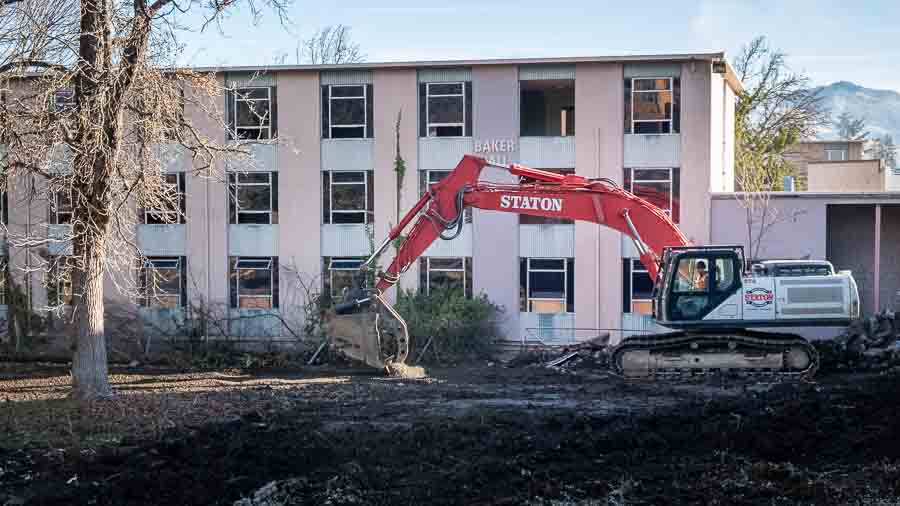
“Although we may have a partner selected sooner rather than later, I think it’s still premature to determine when there might be a contractual agreement in front of the board,” he added.
Asked about how the project could bring in revenue for the university, Bailey said that is still to be determined.
“Depending on which of these two entities becomes the selected partner, there may be opportunities for land-lease agreements, there may be opportunities for risk sharing, there may be opportunities for service providing,” Bailey said. “There are a lot of different ways that the finances could be structured in order to provide a funding stream or multiple funding streams for the university.”
Reach Ashland.news reporter Holly Dillemuth at [email protected].

















